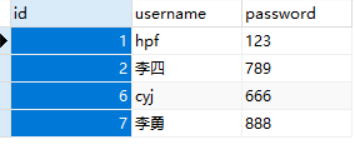MyBatis实现万能Map和模糊查询
目录
- 万能Map
- 模糊查询
万能Map
我们在上一节博文里面将到利用Mybatis实现CRUD操作的时候,我们在数据库表中新增一条数据是这样操作的:
实体类对象的字段有:
package com.hpf.bean;
import lombok.AllArgsConstructor;
import lombok.Data;
import lombok.NoArgsConstructor;
//编写实体类User
@Data
@AllArgsConstructor
@NoArgsConstructor
public class User {
private Long id;
private String username;
private String password;
}
新增一条记录的xml文件配置内容为:
<insert id="addUser" parameterType="com.hpf.bean.User">
insert into userinfo (id,username,password) values (#{id},#{username},#{password})
</insert>
其中,#后带的字段名都是我们实体类用户类里面一模一样的字段名。
接着我们再来试试用Map的方式实现用户记录的新增:
<insert id="addUserByMap" parameterType="Map">
insert into userinfo (id,username,password) values (#{id},#{user},#{pwd})
</insert>
测试部分:
@Test
public void testAddUserByMap(){
SqlSession sqlSession = MyBatisUtils.getSqlSession();
UserDao mapper = sqlSession.getMapper(UserDao.class);
Map<String,Object> map = new HashMap<>();
map.put("id", 6L);
map.put("user", "张三");
map.put("pwd", "666");
int res = mapper.addUserByMap(map);
sqlSession.commit();
sqlSession.close();
}
说明:我们业务相关的参数需要哪些字段内容,我们就往map里面传哪些字段内容就行。
模糊查询
要求查询下表内为李性的用户信息:

package com.hpf.dao;
import com.hpf.bean.User;
import java.util.List;
import java.util.Map;
//这个接口实现的是对于用户的相关操作
public interface UserDao {
//模糊查询用户信息
List<User> getUserByLike(Map map);
}
<select id="getUserByLike" parameterType="Map" resultType="com.hpf.bean.User">
select * from userinfo where username like #{value}
</select>
@Test
public void testGetUserByLike(){
SqlSession sqlSession = MyBatisUtils.getSqlSession();
UserDao mapper = sqlSession.getMapper(UserDao.class);
Map<String,Object> map = new HashMap<>();
map.put("value", "李%");
List<User> userByLike = mapper.getUserByLike(map);
for(User user:userByLike)
System.out.println(user);
}
结果如图所示:

说明:模糊查询在这种方式下其实还有一种写法也可以得出结果,但是为了防止sql注入问题,我们不建议如下的写法:
<select id="getUserByLike" parameterType="Map" resultType="com.hpf.bean.User">
select * from userinfo where username like #{value}"%"
</select>
到此这篇关于MyBatis实现万能Map和模糊查询的文章就介绍到这了,更多相关MyBatis 万能Map和模糊查询内容请搜索我们以前的文章或继续浏览下面的相关文章希望大家以后多多支持我们!
赞 (0)

